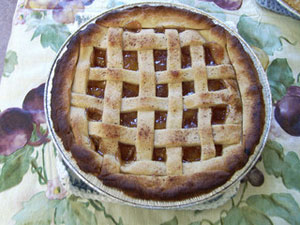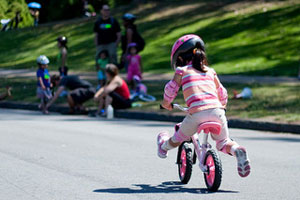
Source: Peach Pie, librarykitty, Flickr
If you have completed the previous sections on metaphor, allusions, and symbolism, you have learned the most difficult concepts. Now, it’s time to tackle imagery. Imagery appeals to any of the five senses: sight, sound, touch, smell, and taste. If you can almost see what the poet is describing, sight imagery is being used; if you can nearly hear what the poet is describing, sound imagery is being used. If the poet describes the feel or texture of an object, the imagery is appealing to your sense of touch. If you can almost smell what is being described, the imagery is appealing to your sense of smell, and if you can almost taste it—you guessed it—the imagery is appealing to your sense of taste.
Take a look at the phrases below. Drag the type of imagery from the right column to the example that represents it in the left column.

 Now, read the poem below. Click on any words or phrases you think may denote imagery. If you chose correctly, a highlight will be added to the word or phrase. Then, use your notes to write which types of imagery (sight, sound, touch, smell, taste) the poet uses and how that imagery helps you understand the poem’s meaning. When you are finished, check your understanding to see a sample response.
Now, read the poem below. Click on any words or phrases you think may denote imagery. If you chose correctly, a highlight will be added to the word or phrase. Then, use your notes to write which types of imagery (sight, sound, touch, smell, taste) the poet uses and how that imagery helps you understand the poem’s meaning. When you are finished, check your understanding to see a sample response. To a Daughter Leaving Home

Source: free wheeling, kate at yr own risk, Flickr
When I taught you
at eight to ride
a bicycle, loping along
beside you
as you wobbled away
on two round wheels,
my own mouth rounding
in surprise when you pulled
ahead down the curved
path of the park,
I kept waiting
for the thud
of your crash as I
sprinted to catch up,
while you grew
smaller, more breakable
with distance,
pumping, pumping
for your life, screaming
with laughter,
the hair flapping
behind you like a
handkerchief waving
goodbye.
Sanple Response:
The poet uses sight and sound imagery. She helps the reader “see” how the parent “lope[d] along beside” the bicycle that “wobbled.” She helps us “hear” what the crash might sound like (“thud”) and helps us imagine how quickly the parent would rush to the rider’s aid (“sprinted”). As the girl rides the bike, we can almost see her grow “smaller” as she gets farther from her mother. We can sense how the girl would pump the pedals. Sound imagery is again used when the parent describes her daughter “screaming with laughter,” and we can again “see” the young girl with her “hair flapping . . . like a handkerchief waving goodbye.”
As you can see, imagery is not difficult to spot in poetry. Just look for words as you read that direct you to one of your five senses.